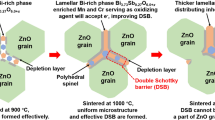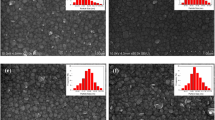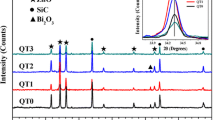Abstract
Varistors are technologically important for their large energy handling capabilities and highly nonlinear electrical behavior when voltages above a characteristic switch field are applied. It is generally accepted that the prototypical ZnO–Bi2O3 varistor system forms electrostatic Schottky barriers at grain boundaries in response to residual Bi and other dopants left at grain surfaces during Bi2O3 segregation. While barrier heights can be modulated with formulation and defect chemistry, mechanisms by which dopant locations, defect compensation, and local phases determine varistor behavior are not completely understood. Bulk studies are challenging due to random grain boundary formation and difficulties studying individual boundaries. To circumvent these challenges in the ZnO–Bi2O3 varistor system, we use as-deposited and post-heat-treated thin film ZnO–Bi2O3 prototypes to simulate bulk varistor grain boundary phase formation and investigate resulting defect chemistry. Characterizing interactions between Bi2O3 films deposited on thin film and single-crystal ZnO by XRD and TEM-EDS revealed primarily Zn-out diffusion, resulting in two (Bi2O3)1−x(ZnO)x, or BZO, phases. Using these results, we present a saturated front model correlating changes in Bi2O3 thickness to phase evolution. We subsequently explore the influence of MnO doping leading to substantial changes in phase evolution for post-heat-treated (Mn:ZnO)–Bi2O3 stacks. Dopant-controlled Bi2O3 phase formations yield a 12 × difference, on average, between nonlinear coefficients for γ*- and β*-BZO.
Graphical Abstract








Similar content being viewed by others
References
Wang ZL, Song J (2006) Piezoelectric nanogenerators based on zinc oxide nanowire arrays. Science 312(80-):242–246. https://doi.org/10.1126/science.1124005
Wang C, Ma S, Sun A et al (2014) Characterization of electrospun Pr-doped ZnO nanostructure for acetic acid sensor. Sens Actuators B Chem 193:326–333. https://doi.org/10.1016/j.snb.2013.11.058
Xian F, Miao K, Bai X et al (2013) Characteraction of Ag-doped ZnO thin film synthesized by sol-gel method and its using in thin film solar cells. Optik (Stuttg) 124:4876–4879. https://doi.org/10.1016/j.ijleo.2013.02.034
Clarke DR (1999) Varistor ceramics. J Am Ceram Soc 82:485–502
Pandey RK, Stapleton WA, Padmini P et al (2012) Magnetically tuned varistor-transistor hybrid device. AIP Adv. https://doi.org/10.1063/1.4773328
Mahan GD, Levinson LM, Philipp HR (1979) Theory of conduction in ZnO varistors. J Appl Phys 50:2799–2812. https://doi.org/10.1063/1.326191
Selim FA, Gupta TK, Hower PL, Carlson WG (1980) Low voltage ZnO varistor: device process and defect model. J Appl Phys 51:765–768. https://doi.org/10.1063/1.327338
Ji-Le L, Chen GH, Yuan CL (2013) Microstructure and electrical properties of rare earth doped ZnO-based varistor ceramics. Ceram Int 39:2231–2237. https://doi.org/10.1016/j.ceramint.2012.08.067
Matsuoka M (1971) Nonohmic properties of zinc oxide ceramics. Jpn J Appl Phys 10:736–746
Lin W, Xu Z, Wang Z et al (2020) Influence of Bi3Zn2Sb3O14 pre-synthesis phase on electrical properties of the ZnO–Bi2O3 based varistor ceramics. J Alloys Compd 834:155070. https://doi.org/10.1016/j.jallcom.2020.155070
Nahm CW, Shin BC, Park JA, Yoo DH (2006) Effect of CoO on nonlinear electrical properties of praseodymia-based ZnO varistors. Mater Lett 60:164–167. https://doi.org/10.1016/j.matlet.2005.08.010
Dosch RG, Tuttle BA, Brooks RA (1986) Chemical preparation and properties of high-field zinc oxide varistors. J Mater Res 1:90–99. https://doi.org/10.1557/JMR.1986.0090
Kim J, Kimura T, Yamaguchi T (1984) Sintering of zinc oxide doped with antimony and bismuth oxide. J Am Ceram Soc 72:1390–1395
Cho SG, Lee H, Kim HS (1997) Effect of chromium on the phase evolution and microstructure of ZnO doped with bismuth and antimony. J Mater Sci 32:4283–4287. https://doi.org/10.1023/A:1018607503494
Wu ZH, Fang JH, Xu D et al (2010) Effect of SiO2 addition on the microstructure and electrical properties of ZnO-based varistors. Int J Miner Metall Mater 17:86–91. https://doi.org/10.1007/s12613-010-0115-0
Sabri MGM, Azmi BZ, Rizwan Z et al (2011) Effect of temperature treatment on the optical characterization of ZnO–Bi2O3–TiO2 varistor ceramics. Int J Phys Sci 6:1388–1394. https://doi.org/10.5897/IJPS10.345
Long W, Hu J, Liu J et al (2010) The effect of aluminum on electrical properties of ZnO varistors. J Am Ceram Soc 93:2441–2444. https://doi.org/10.1111/j.1551-2916.2010.03787.x
Meng P, Gu S, Wang J et al (2018) Improving electrical properties of multiple dopant ZnO varistor by doping with indium and gallium. Ceram Int 44:1168–1171. https://doi.org/10.1016/j.ceramint.2017.07.173
Cheng X, Lu Z, Liu X et al (2020) Improvement of surge current performances of ZnO varistor ceramics via C3N4-doping. J Eur Ceram Soc 40:2390–2395. https://doi.org/10.1016/j.jeurceramsoc.2020.01.067
Harwig HA, Gerards AG (1978) Electrical properties of the α, β, γ, and δ phases of bismuth sesquioxide. J Solid State Chem 26:265–274. https://doi.org/10.1016/0022-4596(78)90161-5
de la Rubia MA, Fernandez JF, Caballero AC (2005) Equilibrium phases in the Bi2O3-rich region of the ZnO–Bi2O3 system. J Eur Ceram Soc 25:2215–2217. https://doi.org/10.1016/j.jeurceramsoc.2005.03.033
He J, Liu J, Hu J et al (2011) Non-uniform ageing behavior of individual grain boundaries in ZnO varistor ceramics. J Eur Ceram Soc 31:1451–1456. https://doi.org/10.1016/j.jeurceramsoc.2011.01.024
Raidl N, Sartory B, Supancic P, Danzer R (2018) Modern methods for the microscopic characterization of ZnO varistor grain boundaries. Prakt Metallogr Metallogr 55:192–202. https://doi.org/10.3139/147.110511
Van Kemenade JTC, Eijnthoven RK (1979) Direct determination of barrier voltage in ZnO varistors. J Appl Phys 50:938–941. https://doi.org/10.1063/1.326015
Tanaka A, Mukae K (1999) ICTS measurements of single grain boundaries in ZnO:rare-earth varistor. J Electroceram 4:55–59. https://doi.org/10.1023/A:1009973704222
Tao M, Ai B, Dorlanne O, Loubiere A (1987) Different “single grain junctions” within a ZnO varistor. J Appl Phys 61:1562–1567. https://doi.org/10.1063/1.338091
Takemura T, Kobayahi M, Takada Y, Sato K (1986) Effects of bismuth sesquioxide on the characteristics of ZnO varistors. J Am Ceram Soc 69:430–436
Mizutani T, Suzuoki Y, Ieda M (1990) Electrical properties of ZnO–Bi2O3 thin-film varistors. J Phys D Appl Phys 20:88–96
Wang Y, Peng Z, Wang Q et al (2017) High-performance varistors simply by hot-dipping zinc oxide thin films in Pr6O11: influence of temperature. Sci Rep 7:1–13. https://doi.org/10.1038/srep41994
Eda K, Eguchi H, Okinaka H, Matsuoka M (1983) Thin-film bulk-type ZnO varistor fabricated by RF sputtering. Jpn J Appl Phys Part 1 Regul Pap Short Notes Rev Pap 22:202. https://doi.org/10.1143/jjap.22.202
Chang K-M, Liu C-P, Tsai C-M (2019) Microstructure and electrical properties of zinc oxide thin film varistors prepared by RF sputtering. MRS Online Proc Library 786:347–352. https://doi.org/10.1557/PROC-786-E6.2
Chiou B, Chen T, Duh J (1987) Electrical properties of ZnO–Bi2O3 thin-film varistors. J Phys D Appl Phys 20:511–517
Wang Q, Peng Z, Wang Y, Fu X (2018) Highly nonlinear varistors fabricated by hot-dipping tin oxide thin films in Ta2O5 powder at different temperatures. Ceram Int 44:6894–6903. https://doi.org/10.1016/j.ceramint.2018.01.115
Karanović L, Poleti D, Vasović D (1994) On the possibility of pyrochlore phase formation in zinc oxide varistor ceramic. Mater Lett 18:191–196. https://doi.org/10.1016/0167-577X(94)90229-1
Wong J (1975) Microstructure and phase transformation in a highly non-Ohmic metal oxide varistor ceramic. J Appl Phys 46:1653–1659. https://doi.org/10.1063/1.321768
Kang X, Floyd R, Lowum S et al (2019) Mechanism studies of hydrothermal cold sintering of zinc oxide at near room temperature. J Am Ceram Soc 102:4459–4469. https://doi.org/10.1111/jace.16340
Kang X (2017) Hydrothermal cold sintering. North Carolina State University, Raleigh
Leite ER, Nobre MAL, Longo E, Varela JA (1996) Microstructural development of ZnO varistor during reactive liquid phase sintering. J Mater Sci 31:5391–5398. https://doi.org/10.1007/BF01159308
Rahaman M, Tuttle B, Voigt J (1990) Low-temperature sintering of zinc oxide varistors. J Mater Sci 25:737–742. https://doi.org/10.1007/BF00714102
Cheng LH, Zheng LY, Meng L et al (2012) Electrical properties of Al2O3-doped ZnO varistors prepared by sol–gel process for device miniaturization. Ceram Int 38:S457–S461. https://doi.org/10.1016/j.ceramint.2011.05.039
Shannon RD (1976) Revised effective ionic radii and systematic studies of interatomic distances in halides and chalcogenides. Acta Cryst A 32:751–767. https://doi.org/10.1023/A:1018927109487
Wolfe RW, Newnham RE (1969) Rare earth bismuth titanates. J Electrochem Soc Solid State Sci 116:832–835
Harwig HA (1978) On the structure of bismuthsesquioxide. Zeitschrift fur Anorg und Allg Chemie 444:151–166. https://doi.org/10.1090/gsm/146/03
Guha JP, Kunej Š, Suvorov D (2004) Phase equilibrium relations in the binary system Bi2O3–ZnO. J Mater Sci 39:911–918. https://doi.org/10.1023/B:JMSC.0000012921.62765.05
Craig DC, Stephenson NC (1975) Structural studies of some body-centered cubic phases of mixed oxides involving Bi2O3: the structures of Bi25FeO40 and Bi38ZnO60. J Solid State Chem 15:1–8. https://doi.org/10.1016/0022-4596(75)90264-9
Radaev SF, Simonov VI, Kargin YF (1992) Structural features of γ-phase Bi2O3 and its place in the sillenite family. Acta Crystallogr Sect B 48:604–609. https://doi.org/10.1107/S0108768192003847
Radaev SF, Muradyan LA, Simonov VI (1991) Atomic structure and crystal chemistry of sillenites: Bi12(Bi3+0.50Fe3+0.50)O19.50 and Bi12(Bi3+0.67Zn2+0.33)O19.33. Acta Crystallogr Sect B 47:1–6. https://doi.org/10.1107/S0108768190007492
Onreabroy W, Sirikulrat N, Brown AP et al (2006) Properties and intergranular phase analysis of a ZnO–CoO–Bi2O3 varistor. Solid State Ionics 177:411–420. https://doi.org/10.1016/j.ssi.2005.10.032
Troemel M, Delicat U, Ducke A, Muench E (1991) Powder Diffraction File, No. 42-185 (*) (1992), ICDD Grant-in-Aid
Royen P, Swars K (1957) Das system wismutoxyd-eisenoxyd im bereich von 0 bis 55 Mol% Eisenoxyd. Zeitschrift fur Anorg und Allg Chemie 69:779
Gattow G, Schroder H (1962) Die Kristallstruktur der Hochtemperaturmodifikation von Wismut(III)-oxid. Zeitschrift fur Anorg und Allg Chemie 318:176–189
Levin EM, Roth RS (1964) Polymorphism of bismuth sesquioxide. I. Pure Bi2O3. J Res Natl Bur Stand Sect A Phys Chem 68A:189–195. https://doi.org/10.6028/jres.068a.019
Westin G, Ekstrand Å, Nygren M et al (1994) Preparation of ZnO-based varistors by the sol–gel technique. J Mater Chem 4:615–621. https://doi.org/10.1039/JM9940400615
Jan K (2017) Electrical and microstructural characterization of doped ZnO based multilayer varistors. Microelectron Int 34:116–120. https://doi.org/10.1108/MI-02-2017-0009
Kulawik J, Szwagierczak D, Skwarek A (2017) Electrical and microstructural characterization of doped ZnO based multilayer varistors. Microelectron Int 34:116–120. https://doi.org/10.1108/MI-02-2017-0009
Han J, Mantas PQ, Senos AMR (2002) Defect chemistry and electrical characteristics of undoped and Mn-doped ZnO. J Eur Ceram Soc 22:49–59
Takada M, Sato Y, Yoshikado S (2009) Observation of Microstructure of Grain Boundaries of ZnO Varistors using Backscattered-electron. Mater Res Soc Symp Proc 1108:1–7
Imura M, Tanaka T, Homma M, Okada M (1994) Nonlinear current voltage characteristics of double layered ZnO rare earth sputtered films.pdf. Mater Trans JIM 35:730–734
Chang KM, Liu CP, Tsai CM (2003) Microstructure and electrical properties of zinc oxide thin film varistors prepared by RF sputtering. Mater Res Soc Symp Proc 786:347–352. https://doi.org/10.1557/proc-786-e6.2
Yano Y, Morooka H (1994) Fabrication of thin-film varistors using sputtering technique. J Ceram Soc Jpn 102:305–308
Yano Y, Shirakawa Y, Morooka H (1992) Electrical properties of ZnO/PrCoOxide multilayered composistes. J Ceram Soc Jpn 100:547–550
Acknowledgements
The authors would like to thank Dr. Richard Floyd and Sarah Lowum for assistance with the cold sintering of ceramic PLD targets, as well as Jennifer Grey for transmission electron microscopy measurements.
Funding
This work was supported by Sandia National Labs and the United State Department of Energy. Sandia National Laboratories is a multimission laboratory managed and operated by National Technology & Engineering Solutions of Sandia, LLC, a wholly owned subsidiary of Honeywell International Inc., for the U.S. Department of Energy’s National Nuclear Security Administration under contract DE-NA0003525.
Author information
Authors and Affiliations
Corresponding author
Additional information
Handling Editor: Kevin Jones.
Publisher's Note
Springer Nature remains neutral with regard to jurisdictional claims in published maps and institutional affiliations.
Rights and permissions
About this article
Cite this article
Ferri, K., Paisley, E.A., DiAntonio, C. et al. Investigation of phase evolution within ZnO–Bi2O3 varistors utilizing thin film prototypes. J Mater Sci 56, 12740–12752 (2021). https://doi.org/10.1007/s10853-021-06101-y
Received:
Accepted:
Published:
Issue Date:
DOI: https://doi.org/10.1007/s10853-021-06101-y




